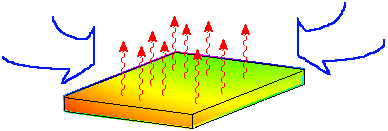Convection is the heat transfer mode in which heat transfers between a solid face and an adjacent moving fluid (or gas). Convection has two elements:
- Energy transfer due to random molecular motion (diffusion), and
- Energy transfer by bulk or macroscopic motion of the fluid (advection).
The mechanism of convection can be explained as follows: as the layer of the fluid adjacent to the hot surface becomes warmer, its density decreases (at constant pressure, density is inversely proportional to the temperature) and becomes buoyant. A cooler (heavier) fluid near the surface replaces the warmer fluid and a pattern of circulation forms.

The rate of heat exchange between a fluid of temperature Tf and a face of a solid of area A at temperature Ts obeys the Newton's law of cooling which can be written as:
Qconvection = h A (Ts - Tf)
where h is the convection heat transfer coefficient. The units of h are W/m2.K or Btu/s.in2.F. The convection heat transfer coefficient (h) depends on fluid motion, geometry, and thermodynamic and physical properties.
Generally, there are two modes convection heat transfer:
Natural (Free) Convection
The motion of the fluid adjacent to a solid face is caused by buoyancy forces induced by changes in the density of the fluid due to differences in temperature between the solid and the fluid. When a hot plate is left to cool down in the air the particles of air adjacent to the face of the plate get warmer, their density decreases, and hence they move upward.

Forced Convection
An external means such as a fan or a pump is used to accelerate the flow of the fluid over the face of the solid. The rapid motion of the fluid particles over the face of the solid maximizes the temperature gradient and increases the rate of heat exchange. In the following image, air is forced over a hot plate.
